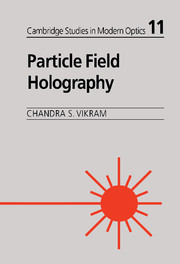Book contents
- Frontmatter
- Contents
- Foreword
- Preface
- Acknowledgements
- 1 Historical background
- 2 Introduction to holography
- 3 General theory of in-line Fraunhofer holography
- 4 System design considerations
- 5 Practical considerations
- 6 Analysis of reconstruction
- 7 Aberrations and their control
- 8 Hologram fringe-contrast and its enhancement
- 9 Non-image plane analysis
- 10 Velocimetry and high speed holography
- 11 The off-axis approach
- References
- Index
5 - Practical considerations
Published online by Cambridge University Press: 13 October 2009
- Frontmatter
- Contents
- Foreword
- Preface
- Acknowledgements
- 1 Historical background
- 2 Introduction to holography
- 3 General theory of in-line Fraunhofer holography
- 4 System design considerations
- 5 Practical considerations
- 6 Analysis of reconstruction
- 7 Aberrations and their control
- 8 Hologram fringe-contrast and its enhancement
- 9 Non-image plane analysis
- 10 Velocimetry and high speed holography
- 11 The off-axis approach
- References
- Index
Summary
In Chapter 4, we discussed the optics necessary for system designing to record and reconstruct an in-line Fraunhofer hologram. A single microobject model and the simplest mode of recording and reconstruction were considered. The technique often finds limitations in practical situations. For example, if the density of the microobjects in the test-section is high, no reference beam might be present in the transmitted light. Thus, there is a practical limit on the density for the successful recording and hence reconstruction. In some other situations, the ideal position of the recording medium may not be practical. This, for example, could be inside a combustion chamber. The scene in that situation can be relayed to a convenient location using lenses. A number of these practical limitations and possible ways to circumvent them are considered in this chapter.
Techniques to enhance the image quality such as special recording and/or processing of the hologram, spatial frequency filtering methods, etc. are also described.
Density of microobjects
In Chapter 3 we saw that an in-line hologram is formed by the interference between the directly transmitted light and the diffraction pattern produced by the microobject. For a single microobject, there is no problem because the reference beam is present almost everywhere. When the number of microobjects increases in a given cross-sectional area, the effective presence of the reference beam will reduce and hence the hologram recording process will be affected. In fact, this is the simple way to describe the situation.
Information
- Type
- Chapter
- Information
- Particle Field Holography , pp. 67 - 115Publisher: Cambridge University PressPrint publication year: 1992
